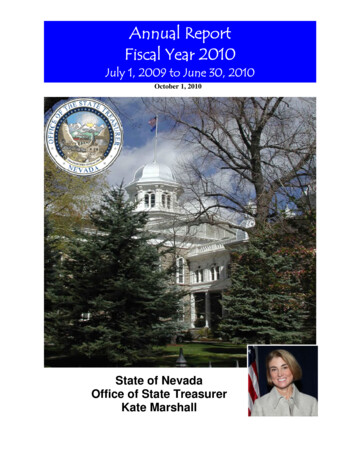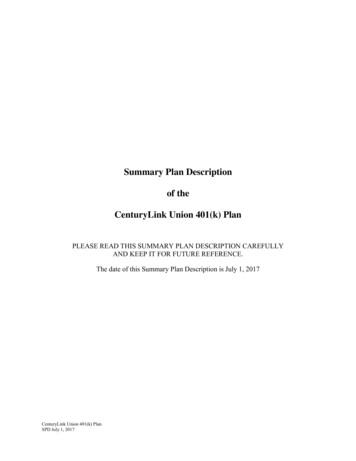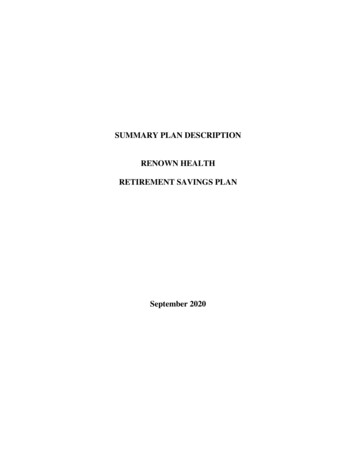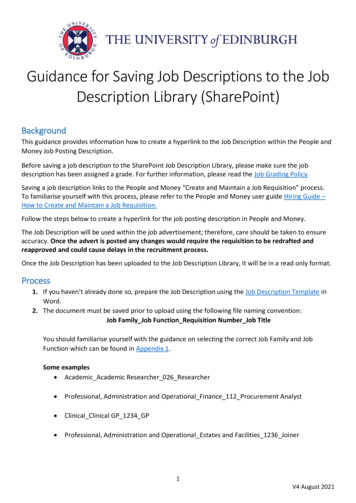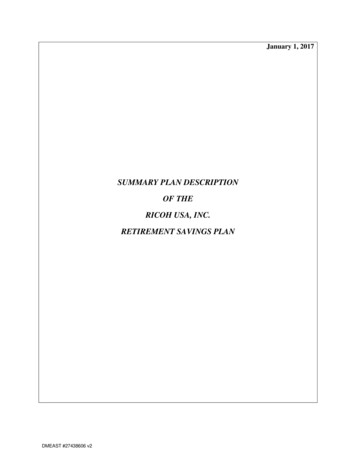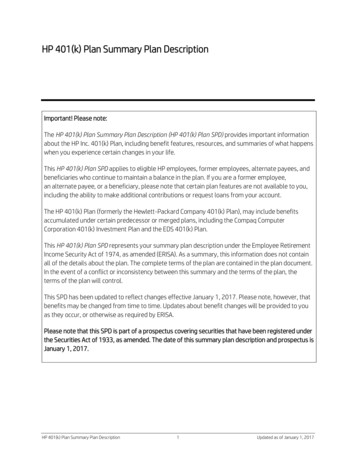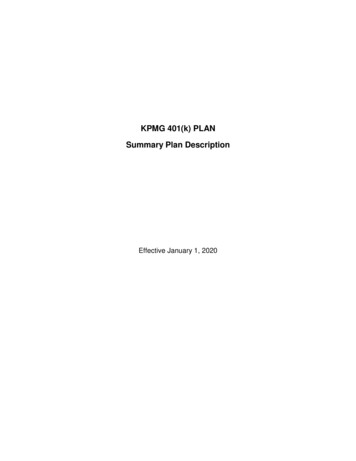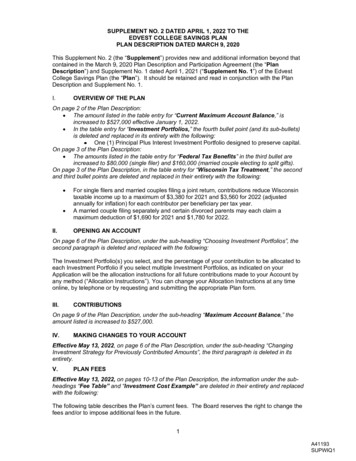
Transcription
SUPPLEMENT NO. 2 DATED APRIL 1, 2022 TO THEEDVEST COLLEGE SAVINGS PLANPLAN DESCRIPTION DATED MARCH 9, 2020This Supplement No. 2 (the “Supplement”) provides new and additional information beyond thatcontained in the March 9, 2020 Plan Description and Participation Agreement (the “PlanDescription”) and Supplement No. 1 dated April 1, 2021 (“Supplement No. 1”) of the EdvestCollege Savings Plan (the “Plan”). It should be retained and read in conjunction with the PlanDescription and Supplement No. 1.OVERVIEW OF THE PLANI.On page 2 of the Plan Description: The amount listed in the table entry for “Current Maximum Account Balance,” isincreased to 527,000 effective January 1, 2022. In the table entry for “Investment Portfolios,” the fourth bullet point (and its sub-bullets)is deleted and replaced in its entirety with the following: One (1) Principal Plus Interest Investment Portfolio designed to preserve capital.On page 3 of the Plan Description: The amounts listed in the table entry for “Federal Tax Benefits” in the third bullet areincreased to 80,000 (single filer) and 160,000 (married couple electing to split gifts).On page 3 of the Plan Description, in the table entry for “Wisconsin Tax Treatment,” the secondand third bullet points are deleted and replaced in their entirety with the following: II.For single filers and married couples filing a joint return, contributions reduce Wisconsintaxable income up to a maximum of 3,380 for 2021 and 3,560 for 2022 (adjustedannually for inflation) for each contributor per beneficiary per tax year.A married couple filing separately and certain divorced parents may each claim amaximum deduction of 1,690 for 2021 and 1,780 for 2022.OPENING AN ACCOUNTOn page 6 of the Plan Description, under the sub-heading “Choosing Investment Portfolios”, thesecond paragraph is deleted and replaced with the following:The Investment Portfolio(s) you select, and the percentage of your contribution to be allocated toeach Investment Portfolio if you select multiple Investment Portfolios, as indicated on yourApplication will be the allocation instructions for all future contributions made to your Account byany method (“Allocation Instructions”). You can change your Allocation Instructions at any timeonline, by telephone or by requesting and submitting the appropriate Plan form.III.CONTRIBUTIONSOn page 9 of the Plan Description, under the sub-heading “Maximum Account Balance,” theamount listed is increased to 527,000.IV.MAKING CHANGES TO YOUR ACCOUNTEffective May 13, 2022, on page 6 of the Plan Description, under the sub-heading “ChangingInvestment Strategy for Previously Contributed Amounts”, the third paragraph is deleted in itsentirety.V.PLAN FEESEffective May 13, 2022, on pages 10-13 of the Plan Description, the information under the subheadings “Fee Table” and “Investment Cost Example” are deleted in their entirety and replacedwith the following:The following table describes the Plan’s current fees. The Board reserves the right to change thefees and/or to impose additional fees in the future.1A41193SUPWIQ1
atedExpenses ofan 8/2039 Enrollment Portfolio0.07%0.00%0.07%0.14%2036/2037 Enrollment Portfolio0.07%0.00%0.08%0.15%2034/2035 Enrollment Portfolio0.07%0.00%0.08%0.15%2032/2033 Enrollment Portfolio0.07%0.00%0.08%0.15%2030/2031 Enrollment Portfolio0.07%0.00%0.09%0.16%2028/2029 Enrollment Portfolio0.07%0.00%0.09%0.16%2026/2027 Enrollment Portfolio0.07%0.00%0.09%0.16%2024/2025 Enrollment Portfolio0.07%0.00%0.08%0.15%2022/2023 Enrollment Portfolio0.07%0.00%0.06%0.13%In School Portfolio0.07%0.00%0.05%0.12%Investment PortfolioTotal AnnualAsset-BasedFees(5)Enrollment Year Investment PortfoliosMulti-Fund Investment PortfoliosIndex-Based Aggressive Portfolio0.07%0.00%0.06%0.13%Index-Based Moderate Portfolio0.07%0.00%0.07%0.14%Index-Based Conservative Portfolio0.07%0.00%0.05%0.12%Active-Based Aggressive Portfolio0.07%0.00%0.22%0.29%Active-Based Moderate Portfolio0.07%0.00%0.28%0.35%Active-Based Conservative Portfolio0.07%0.00%0.19%0.26%Balanced Portfolio0.07%0.00%0.06%0.13%International Equity Index Portfolio0.07%0.00%0.08%0.15%Single Fund Investment PortfoliosSmall-Cap Index Portfolio0.07%0.00%0.05%0.12%U.S. Equity Active Portfolio0.07%0.00%0.14%0.21%Large-Cap Stock Index Portfolio0.07%0.00%0.05%0.12%Social Choice Portfolio0.07%0.00%0.17%0.24%Bond Index Portfolio0.07%0.00%0.08%0.15%N/AN/AN/AN/APrincipal Plus Interest Investment PortfolioPrincipal Plus Interest Portfolio (6)(1)Although the Plan Manager Fee is deducted from an Investment Portfolio, not from yourAccount, each Account in the Investment Portfolio indirectly bears its pro rata share of the PlanManager Fee as this fee reduces the Investment Portfolio’s return.(2)Each Investment Portfolio (with the exception of the Principal Plus Interest Portfolio) pays thePlan Manager a fee at an annual rate of 0.07% (7 basis points) of the average daily net assets ofthe Investment Portfolio. This 0.07% fee applies on total assets in the Plan up to 5.0 billion.The Plan Manager Fee will be reduced to 0.06% effective on the first day of the month followingthe date Plan assets reach or exceed 5.0 billion.(3)The State Administrative Fee is a fee that the Board may collect for its services to the Plan. TheBoard has waived the State Administrative Fee through October 29, 2023. If the waiver was nolonger in effect, the State Administrative Fee would be 0.10% of the average daily net assets ofthe Investment Portfolios (other than the Principal Plus Interest Portfolio).(4)The percentages set forth in this column are based on the expense ratios of the mutual funds inwhich an Investment Portfolio invests. The amounts are calculated using the expense ratioreported in each mutual fund’s prospectus effective as of the date that this Plan Description was2
finalized for printing, weighted according to the Investment Portfolio’s allocation among themutual funds in which it invests. Although these expenses are not deducted from an InvestmentPortfolio’s assets, each Investment Portfolio (other than the Principal Plus Interest Portfolio)indirectly bears its pro rata share of the expenses of the mutual fund(s) in which it invests asthese expenses reduce such mutual fund(s) returns.(5)These figures represent the estimated weighted annual expense ratios of the mutual funds inwhich the Investment Portfolios invest plus the fee paid to the Plan Manager.(6)The Principal Plus Interest Portfolio does not pay a Plan Manager Fee or a State AdministrativeFee. TIAA-CREF Life Insurance Company (“TIAA-CREF Life”), the issuer of the fundingagreement in which this Investment Portfolio invests and an affiliate of TFI, makes payments toTFI, as Plan Manager. This payment, among many other factors, is considered by the issuerwhen determining the interest rates credited under the funding agreement.Investment Cost Example. The example in the following table is intended to help you comparethe cost of investing in the different Investment Portfolios over various periods of time. Thisexample assumes that: You invest 10,000 in an Investment Portfolio for the time periods shown below.Your investment has a 5% compounded return each year.You withdraw your entire investment from the Investment Portfolio at the end of thespecified periods for Qualified Higher Education Expenses.Total Annual Asset-Based Fees remain the same as those shown in the Fee Table aboveand that the Board’s waiver of the State Administrative Fee continues in effect for each ofthe time periods shown below.Although your actual costs may be higher or lower, based on the above assumptions, your costswould be:INVESTMENT PORTFOLIOSAPPROXIMATE COST OF 10,000 INVESTMENT(1)1 Year3 Years5 Years10 Years2038/2039 Enrollment Portfolio 14 45 79 1792036/2037 Enrollment Portfolio 15 48 85 1922034/2035 Enrollment Portfolio 15 48 85 1922032/2033 Enrollment Portfolio 15 48 85 1922030/2031 Enrollment Portfolio 16 52 90 2052028/2029 Enrollment Portfolio 16 52 90 2052026/2027 Enrollment Portfolio 16 52 90 2052024/2025 Enrollment Portfolio 15 48 85 1922022/2023 Enrollment Portfolio 13 42 73 167In School Portfolio 12 39 68 154Index-Based Aggressive Portfolio 13 42 73 167Index-Based Moderate Portfolio 14 45 79 179Index-Based Conservative Portfolio 12 39 68 154Active-Based Aggressive Portfolio 30 93 163 369Active-Based Moderate Portfolio 36 113 197 444Active-Based Conservative Portfolio 27 84 146 331Enrollment Year Investment PortfoliosMulti-Fund Investment PortfoliosBalanced Portfolio 13 42 73 167International Equity Index Portfolio 15 48 85 1923
Single Fund Investment PortfoliosSmall-Cap Index Portfolio 12 39 68 154U.S. Equity Active Portfolio 22 68 118 268Large-Cap Stock Index Portfolio 12 39 68 154Social Choice Portfolio 25 77 135 306Bond Index Portfolio 15 48 85 192N/AN/AN/AN/APrincipal Plus Interest Investment PortfolioPrincipal Plus Interest Portfolio(1)These examples reflect the Board’s waiver of the 0.10% State Administrative Fee for each timeperiod set forth above. In the event the waiver was to be rescinded, the applicable coststhereafter would increase.VI.INVESTMENT PORTFOLIOSEffective May 13, 2022, on pages 13-14, all references to Investment Portfolios investing in CDsare deleted.Effective May 13, 2022, the following information is added as a new bullet point under the revisedsub-heading, “Information about the Funding Agreements and the Mutual Funds in which theInvestment Portfolios Invest.”: calling 1-800-662-7447 or visiting www.vanguard.com/prospectus for the Vanguard funds.Effective May 13, 2022, beginning on page 16, the two paragraphs under the sub-heading“Investment Risks” are deleted in their entirety and replaced with the following:Through their investments in mutual funds and a funding agreement, the Enrollment Year InvestmentPortfolios are subject to the following investment risks (in alphabetical order): Active ManagementRisk, Call Risk, Concentration Risk (includes Industry and Asset Concentration Risks), Credit Risk,Credit Spread Risk, Currency Risk, Cybersecurity Risk, Downgrade Risk, Emerging Markets Risk,Extension Risk, Fixed-Income Foreign Investment Risk, Floating and Variable Rate Securities Risk,Floating Rate Loan Risk, Foreign Investment Risk, Illiquid Investments Risk, Impairment of CollateralRisk, Income Volatility Risk, Index Risk, Interest Rate Risk, Investment Style Risk, Issuer Risk(sometimes referred to as Financial Risk), Large-Cap Risk, LIBOR Risk, Market Risk, Market Volatility,Liquidity and Valuation Risk (types of Market Risk), Mid-Cap Risk, Nondiversification Risk, NonInvestment-Grade Securities Risk, Prepayment Risk, Real Interest Rate Risk, Senior Loan Risk, SmallCap Risk, U.S. Government Securities Risk, and the risk that TIAA-CREF Life could fail to perform itsobligations under the funding agreement for financial or other reasons.Effective May 13, 2022, on page 17, the table included under the sub-heading “Target AssetAllocations for the Enrollment Year Investment Portfolios” is deleted and replaced with thefollowing:Allocations for the Enrollment Year Investment PortfoliosTIAACREFEnrollment Year 50.40%TIAACREFTIAACREFEmerging VanguardInternational ndFund(TCIEX)(TEQLX) (VGSNX)19.20%4.80%5.60%VanguardT. RoweTIAA- Short-TermPriceCREFInflation- Vanguard InstitutionalTIAABondProtected High-Yield FloatingCREFIndexSecurities CorporateRateLifeFund Index FundFundingFundFund(TBIIX)(VTSPX) %4.20%3.15%2.10%0.00%
0%4.80%1.20%1.40%22.00%8.00%6.00%4.00%40.00%In tive May 13, 2022, on page 19, the table “Allocations for the Index-Based Multi-FundPortfolios” is deleted and replaced with the following:Index-BasedMulti-Fund PortfolioIndex-BasedAggressive PortfolioIndex-BasedModerate PortfolioIndex-BasedConservative xReal EstateFundIndex uardShort-TermInflationProtectedSecuritiesIndex alEquity ngFund(VWEAX) AgreementEffective May 13, 2022, on page 19 of the Plan Description, the two paragraphs under the subheading “Investment Risks for each of the Three Index-Based Multi-Fund Portfolios” aredeleted in their entirety and replaced with the following:Through their investments in mutual funds and a funding agreement, the Index-Based Multi-FundPortfolios are subject to the following investment risks (in alphabetical order): Active ManagementRisk, Call Risk, Concentration Risk (includes Industry and Asset Concentration Risks), Credit Risk,Credit Spread Risk, Currency Risk, Downgrade Risk, Emerging Markets Risk, Extension Risk, FixedIncome Foreign Investment Risk, Floating and Variable Rate Securities Risk, Foreign Investment Risk,Illiquid Investments Risk, Income Volatility Risk, Index Risk, Interest Rate Risk, Investment Style Risk,Issuer Risk (sometimes referred to as Financial Risk), Large-Cap Risk, Market Risk, Market Volatility,Liquidity and Valuation Risk (types of Market Risk), Mid-Cap Risk, Nondiversification Risk, NonInvestment-Grade Securities Risk, Prepayment Risk, Real Interest Rate Risk, Small-Cap Risk, U.S.Government Securities Risk, and the risk that TIAA-CREF Life could fail to perform its obligationsunder the funding agreement for financial or other reasons.Effective May 13, 2022, on pages 24-25:The sub-heading “Stable Principal Investment Portfolios” is replaced with “Principal PlusInterest Investment Portfolio.”The Cash Equivalents and Bank CD Portfolio is merged with the Principal Plus Interest Portfolio.The section titled “Cash Equivalents and Bank CD Portfolio” is deleted in its entirety.The third paragraph under the section titled “Principal Plus Interest Portfolio” is deleted in itsentirety.Effective May 13, 2022, beginning on page 25 of the Plan Description, under the sub-heading“Explanation of the Investment Risks of Investment Portfolios,” the following new risks are addedin alphabetical order:Concentration Risk (includes Industry, and Asset Concentration Risks) — The risk that to theextent that a fund’s portfolio is concentrated in the securities of issuers in a particular market, industry(e.g., real estate), group of industries or sector, a fund may be adversely affected by the performanceof those securities, may be subject to increased price volatility and may be more susceptible toadverse economic, market, political or regulatory occurrences affecting that market, industry, group of5
industries or sector. To the extent that a fund is heavily weighted in its largest holdings, a fund’sperformance may be hurt disproportionately by the poor performance of relatively few stocks.Investment Style Risk — The risk that returns from the stocks of REITs and other real estate-relatedinvestments—which typically are small- or mid-capitalization stocks—will trail returns from the overallstock market. Historically, these stocks have performed quite differently from the overall market.LIBOR Risk — The risk associated with the transition away from LIBOR. Many financial instrumentsuse or may use a floating rate based on the London Interbank Offered Rate, or “LIBOR,” which is theoffered rate for short-term Eurodollar deposits between major international banks. There remainsuncertainty regarding the future utilization of LIBOR and the nature of any replacement rate. Theelimination of LIBOR or changes to other reference rates or any other changes or reforms to thedetermination or supervision of reference rates could have an adverse impact on the market for, orvalue of, any securities or payments linked to those reference rates, which may adversely affect thefund’s performance and/or net asset value.Nondiversification Risk — A diversified investment company under the 1940 Act, may become nondiversified under the 1940 Act without shareholder approval when necessary to continue to track itsbenchmark index. Non-diversified status means that a fund can invest a greater percentage of itsassets in the securities of a single issuer than a diversified fund. A nondiversified fund has the abilityto invest a larger percentage of its assets in the securities of a smaller number of issuers than adiversified fund. As a result, poor performance by a single issuer could adversely affect fundperformance more than if the fund were invested in a larger number of issuers. A nondiversified fund’sshare price can be expected to fluctuate more than that of a similar fund that is more broadlydiversified.Real Interest Rate Risk — The risk that the value of a bond will fluctuate because of a change in thelevel of real, or after inflation, interest rates. Although inflation-indexed bonds seek to provide inflationprotection, their prices may decline when real interest rates rise and vice versa.Effective May 13, 2022, on page 25 of the Plan Description, under the sub-heading “Explanation ofthe Investment Risks of Investment Portfolios,” the description of “Call Risk” is deleted in itsentirety and replaced with the following:Call Risk — During periods of falling interest rates, or due to a number of other reasons (e.g., changesin credit spreads and improvements in the issuer’s credit quality), an issuer may exercise its right toredeem or call (or repay) a fixed-income security earlier than expected and prior to maturity, resultingin an increased turnover rate and a decline in a mutual fund’s income. A fund may be forced toreinvest in lower-yielding securities, securities with greater credit risks or securities with other,less favorable features.VII.RISKS OF INVESTING IN THE PLANThe following is added as a new sub-section under the heading “Risks of Investing in the Plan,”beginning on page 31:Force Majeure. None of the State of Wisconsin, the Department, the Board, the Plan or anyother government agency or entity, or any of the service providers to the Plan, are responsible forcircumstances beyond their reasonable control that may negatively impact your Account. Suchcircumstances include, but are not limited to, regulatory or legislative changes, worldwide politicaluncertainties, and general economic conditions (such as including inflation and unemploymentrates), acts of God, acts of civil or military authority, acts of government, accidents, environmentaldisasters, natural disasters or events, fires, floods, earthquakes, hurricanes, explosions, lightning,suspensions of trading, epidemics, pandemics, public health crises, quarantines, wars, acts ofwar (whether war is declared or not), terrorism, threats of terrorism, insurrections, embargoes,cyber-attacks, riots, strikes, lockouts or other labor disturbances, disruptions of supply chains, civilunrest, revolutions, power or other mechanical failures, loss or malfunction of utilities orcommunications services, delays or stoppage of postal or courier services, delays in or stoppagesof transportation, and any other events or circumstances beyond our reasonable control whethersimilar or dissimilar to any of the foregoing.”6
VIII.PAST PERFORMANCEThe section under the heading “Past Performance” on pages 32-34 is deleted in its entirety andreplaced with the following:The tables below compare the average annual total return of an Investment Portfolio (afterdeducting fees and expenses) to the returns of a benchmark. The benchmark included in thetables combines the benchmark(s) for the underlying investment(s) in which an InvestmentPortfolio invests weighted according to the allocation(s) to those underlying investments(s) andadjusted to reflect any changes in the allocation(s) and/or the benchmark(s) during the relevanttime period. Benchmarks are not available for investment, are not managed and do not reflect thefees or expenses of investing.The performance data shown below represents past performance. Past performance is not aguarantee of future results. Current performance data may be lower or higher than theperformance data below. Performance may be substantially affected over time by changes in theallocations and/or changes in the investments in which each Investment Portfolio invests.Investment returns and the principal value will fluctuate so that your Account, when redeemed,may be worth more or less than the amounts contributed to your Account.For monthly performance information, visit the Plan’s website or call the Plan.Average Annual Total Returns for the Period Ended December 31, 2021Investment Portfolio2038 / 2039 Enrollment Portfolio1 Year3 Year------5 Year---10 Year---Benchmark5.50%Inception DateJune 11, 20215.69%2036 / 2037 Enrollment Portfolio16.87%Benchmark17.15%2034 / 2035 Enrollment Portfolio16.46%Benchmark16.75%2032 / 2033 Enrollment Portfolio15.35%Benchmark15.63%2030 / 2031 Enrollment Portfolio14.02%Benchmark14.37%2028 / 2029 Enrollment Portfolio12.20%Benchmark12.49%2026 / 2027 Enrollment Portfolio10.52%Benchmark10.75%2024 / 2025 Enrollment Portfolio8.84%Benchmark8.93%2022 / 2023 Enrollment Portfolio6.17%Benchmark6.02%In School 1%March 6, 202021.49%---------21.05%March 6, 202021.13%---------19.87%March 6, 202019.99%---------18.34%March 6, 202018.54%---------16.26%March 6, 202016.48%---------14.11%March 6, 202014.34%---------12.12%March 6, ch 6, 20208.91%3.57%March 6, 20204.96%Index-Based Aggressive .04%Index-Based Moderate 3.80%9.79%---8.22%Index-Based Conservative %5.72%7October 26, 201211.55%4.98%October 26, 2012October 26, 2012
Active-Based Aggressive .07%Active-Based Moderate 3.91%9.84%---8.17%Active-Based Conservative %5.33%Balanced %18.47%13.06%---11.57%International Equity Index 12%9.69%Small-Cap Index .02%U.S. Equity Active .97%Large-Cap Stock Index %26.07%18.47%---16.45%Social Choice %25.79%17.97%---16.08%Bond Index 79%3.57%---2.73%Principal Plus Interest r 31, 201211.50%October 31, 2012October 31, 20124.98%October 26, 2012October 26, 20127.09%---13.29%October 26, 201213.20%---15.50%November 5, 201216.19%October 26, 2012November 1, 2012October 26, 2012October 26, 2012OTHER INFORMATIONOn page 36 of the Plan Description, the disclosure under the sub-heading “FinancialStatements,” the second sentence is deleted in its entirety and replaced with the following:You may download a copy of the financial statements at www.edvest.com, or request a copy bycontacting the Plan.X.FEDERAL TAX INFORMATIONOn page 39-40 of the Plan Description, the disclosure under the sub-heading “Federal Gift,Estate and Generation-Skipping Transfer Tax Treatment” is amended by deleting the lastparagraph in its entirety and replacing it with the following:As of the date of this Supplement, the amount of the annual gift tax exclusion is 16,000 per year( 32,000 for married contributors electing to split gifts). The lifetime exemption, estate taxexemption and generation-skipping transfer tax exemption is 12,060,000 for each contributor( 24,120,000 for married couples).XI.WISCONSIN TAX INFORMATIONOn page 40 of the Plan Description, the sixth through ninth sentences of the first paragraphunder the sub-heading “Contributions” are deleted in their entirety and replaced with thefollowing:The maximum contribution deduction for each contributor per Beneficiary is 3,380 for the 2021tax year and 3,560 for the 2022 tax year and may increase annually based on inflation. A marriedcouple filing a joint return may deduct their contributions up to the maximum contribution deductionper Beneficiary each year. A married couple filing separately may each claim a maximumdeduction of 1,690 for 2021 and 1,780 for 2022. Divorced parents are each allowed to claim amaximum deduction of 1,690 for 2021 and 1,780 for 2022, unless the divorce judgment specifies8
a different division of the combined maximum deduction that may be claimed by each formerspouse.XII.OTHER INFORMATION ABOUT YOUR ACCOUNTOn page 41 of the Plan Description under the section “Other Information About Your Account,”the following paragraphs are added:Unclaimed Property Laws: Each state has unclaimed property laws which may require thatfunds associated with checks that are not cashed within a specified period of time be turned overto the applicable state. Some states may require an Account to be turned over to the applicablestate in the event that there is no activity on such Account over a designated period and/or Planmailings are returned to the Manager or its designee. The applicable state for these purposes isusually determined by the most recent address on file of the Account Owner.9
SUPPLEMENT NO. 1 DATED APRIL 1, 2021 TO THEEDVEST COLLEGE SAVINGS PLANPLAN DESCRIPTION DATED MARCH 9, 2020This Supplement No. 1 (the “Supplement”) provides new and additional information beyond thatcontained in the March 9, 2020 Plan Description and Participation Agreement (the “PlanDescription”) of the Edvest College Savings Plan (the “Plan”). It should be retained and read inconjunction with the Plan Description.OVERVIEW OF THE PLANI.On page 2 of the Plan Description, the amount listed in the table entry for “Current MaximumAccount Balance,” is increased to 516,000.On page 3 of the Plan Description, in the table entry for “Wisconsin Tax Treatment,” the secondand third bullet points are deleted and replaced in their entirety with the following: II.For single filers and married couplies filing a joint return, contributions reduce Wisconsintaxable income up to a maximum of 3,340 for 2020 and 3,380 for 2021 (adjustedannually for inflation) for each contributor per beneficiary per tax year.A married couple filing separately and certain divorced parents may each claim amaximum deduction of 1,670 for 2020 and 1,690 for 2021.FREQUENTLY USED TERMSOn page 4 of the Plan Description, in the table entry for “Qualified Higher EducationExpenses,” the second and third paragraphs are deleted in their entirety and replaced with thefollowing:For both federal and Wisconsin tax purposes, any reference to Qualified Higher EducationExpenses also includes (i) a reference to tuition in connection with enrollment or attendance at aprimary (i.e., elementary school) or secondary (i.e., middle school or high school) public, private,or religious school up to a maximum of 10,000 of distributions for such tuition expenses pertaxable year per Designated Beneficiary from all 529 Plans; (ii) expenses for fees, books,supplies, and equipment required for the participation of a Designated Beneficiary in anapprenticeship program registered and certified with the Secretary of Labor under the NationalApprenticeship Act; and (iii) amounts paid as principal or interest on any qualified education loanof either the Beneficiary, or a sibling of the Designated Beneficiary, up to a lifetime limit of 10,000 per individual. Distributions treated as Qualified Higher Education Expenses withrespect to the loans of a sibling of a Designated Beneficiary will count towards the limit of thesibling, not the Designated Beneficiary. Such loan repayments may impact student loan interestdeductibility.III.CONTRIBUTIONSOn page 9 of the Plan Description, the first sentence under “Maximum Account Balance,” isdeleted in its entirety and replaced with the following:Currently, the maximum account balance (also referred to as the maximum contribution limit) forall Accounts in the Program (including the Advisor Plan) for the same beneficiary is 516,000.On page 10 of the Plan Description, a new section called UGMA/UTMA Contributions is added asfollows:UGMA/UTMA Contributions. Because only cash equivalent contributions to an Account arepermitted, UGMA or UTMA assets outside the Plan may need to be liquidated in order tocontribute them to an Account, which may have adverse income tax consequences.1A41008
IV.PLAN FEESEffective June 11, 2021 (although the Plan Manager Fee of 0.07% is effective as of December1, 2020), on pages 10-13 of the Plan Description, the information under the sub-headings “FeeTable” and “Investment Cost Example” are deleted in their entirety and replaced with thefollowing:The following table describes the Plan’s current fees. The Board reserves the right to change thefees and/or to impose additional fees in the future.Fee TablePlan Expenses of 038/2039 Enrollment Portfolio0.07%0.00%0.12%0.19%2036/2037 Enrollment Portfolio0.07%0.00%0.12%0.19%2034/2035 Enrollment Portfo
1 SUPPLEMENT NO. 2 DATED APRIL 1, 2022 TO THE EDVEST COLLEGE SAVINGS PLAN . PLAN DESCRIPTION DATED MARCH 9, 2020 . This Supplement No. 2 (the "Supplement") provides new and additional information beyond that contained in the March 9, 2020 Plan Description and Participation Agreement (the " Plan Description") and Supplement No. 1 dated April 1, 2021 ("Supplement No. 1") of the Edvest
